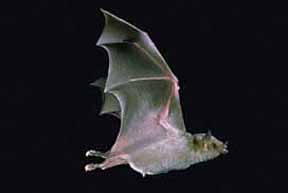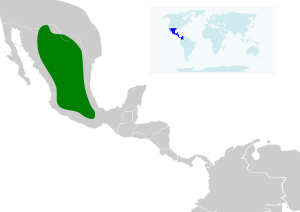Greater long-nosed bat facts for kids
Quick facts for kids Greater long-nosed bat |
|
|---|---|
 |
|
| Conservation status | |
| Scientific classification | |
| Genus: |
Leptonycteris
|
| Species: |
nivalis
|
 |
|
The greater long-nosed bat is also known as the Mexican long-nosed bat. Its scientific name is Leptonycteris nivalis. This amazing bat lives in Mexico and the United States. It mainly eats pollen and nectar, especially from Agave plants and cacti. You can find it in desert areas and open forests. Sadly, its home is shrinking due to habitat loss.
Description
These bats are a sooty brown color. They are darker on their backs and lighter on their bellies. Each hair is white at the bottom and silver at the tip. Their forearms are about 54 to 59 millimeters (2.1 to 2.3 inches) long.
They have a bit of fur on the membrane between their legs. Their short tails have only three small bones called vertebrae. Their muzzles (noses and mouths) are long. Their tongues are also long and have tiny bumps called papillae, like little brushes. These help them collect nectar.
The greater long-nosed bat has a triangular, upright nose-leaf. On average, they weigh about 24 grams (0.8 ounces). Their ears are about 15 millimeters (0.6 inches) long. Like other animals that eat nectar, these bats have smaller teeth. They are even missing their third molar tooth. This is because they don't need to bite or chew their food much.
Where They Live
You can find these bats in southern Texas, Arizona, and New Mexico. They are usually there from June to August. For the rest of the year, they live in central Mexico.
They often sleep in caves and old mines. But they can also be found in empty buildings, hollow trees, and even sewers. Some people thought they lived as far south as Guatemala. However, experts say their southernmost home is central Guerrero, Mexico.
Reproduction and Life Cycle
Scientists haven't studied the reproduction of these bats a lot. But they have some ideas based on what they've seen.
Mating happens in November and December. This is at a cave called Cueva del Diablo in Mexico. It's when there is the most food available around the cave. It's believed that both males and females mate with different partners. They likely breed only once a year.
Baby bats are probably born in May. This is when the females are moving to northern Mexico or the southwestern United States. Usually, a mother bat has only one baby at a time.
Male bats probably do not migrate. Adult males are rarely seen in the United States. Female bats form special groups called maternity colonies. They do this in the northern parts of their range. Mothers and their young arrive at a cave in Texas in June. Some pregnant females arrive as early as mid-April. This means some females give birth after they finish their migration.
Baby bats are thought to start flying in July. The adult females and their young leave Texas in August.
Ecology
The greater long-nosed bat eats nectar from the same plants as the southern long-nosed bat. But these two bat species live in different places. The greater long-nosed bat prefers higher places and cooler temperatures. Both bats live in dry areas. The greater long-nosed bat chooses homes with more pine and oak trees.
These bats mate in only one known cave. It's called Cueva del Diablo, near Tepoztlán, Mexico. They share this cave with the common vampire bat and Parnell's mustached bat.
The greater long-nosed bat eats nectar from many different plants. These include tree-like cacti, Ceiba trees, shaving brush trees, morning glory trees, powder puff plants, flowering shrubs, and four types of Agave plants. These bats are very flexible with their diet. They change what they eat as different plants bloom throughout the year.
Conservation
The number of greater long-nosed bats has likely been going down for many years. In 1988, the United States Fish and Wildlife Service listed it as an endangered animal. This means it is at high risk of disappearing forever.
In 1995, a group of bat experts started a program. It's called The Program for the Conservation of Migratory Bats between Mexico and the United States (PCCM). They started it because many bat species in Mexico were declining. PCCM has been very helpful in counting the greater long-nosed bats in Cueva del Diablo.
To stop damage to Cueva del Diablo and help people appreciate bats, PCCM created many things. These include children's books, fun educational activities, and TV reports. In 2013, Bat Conservation International put this bat on its list of 35 top priority species for conservation worldwide.
These bats live in large groups called colonies. This means that if something bad happens at just one cave, it can hurt a lot of bats. This can have a big negative effect on the entire species.
See also
 In Spanish: Leptonycteris nivalis para niños
In Spanish: Leptonycteris nivalis para niños


